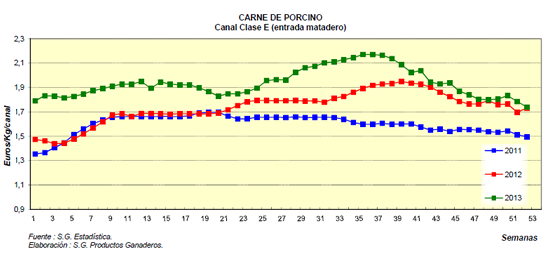The Ministry of Agriculture, Food and Environment has published the complete report on the weekly evolution of the national markets of livestock products of year 2013.
As it can be read in the report, year 2013 has been positive, in general, for the livestock sectors, and it has been characterized by stability and a level of prices that, in most of the sectors, have exceeded those recorded during the previous years.

So, in the case of class E pig meat, the average price of the carcass has increased by 11.4% in 2013 with respect to the previous year. Generalized price increases have also been registered in all beef categories, and the case of the heifers (with a rise by 4%) or the pasturing calves (with a growth by 14.7%) stand out.
The data concerning milk are also very remarkable, with very significant price rises in the case of cow milk (10.3% with regard to the annual average), as well as in the case of sheep and goat milk (9% over the 2012 average), and rabbit meat, with an increase of 6.8% with respect to the prices in 2012.
The combination of this situation together with the reduction in the feeding costs has favoured a considerable improvement of the profitability of the farms, especially in the case of beef, dairy, rabbit and pig farms.
Swine
The average price of the class E carcass in year 2013 in the Spanish market was €1.936/kg, exceeding the price in year 2012 by 11.4%, and reaching historic maximum prices in week 35 (the last week of August), with a price of €2.171/kg of carcass. At the same time, this price was 11.3% higher than in the German market, and 10.3% higher than the EU average.

Indeed, during the whole of year 2013, the Spanish prices remained, with difference, in the highest positions of the ranking with respect to its main competitors. During the first trimester of 2013 the price followed a very similar trajectory, generally speaking, to that of the previous two years, although at a quite higher level. After the drop during the last week of March and the recovery in the first week of April, the price experienced a sustained drop until mid-May. Since then an important rise started, and it touched the ceiling by the end of August, as it has been previously said. With this, just as it happened in 2012, the maximum annual price moved, from the seasonal point of view, towards the end of summer. During the course of the last trimester there was a continuous drop of the price for, after some upward rises, end up year 2013 at levels near to those of year 2012. Finally, we must quote that during a good part of year 2013, record prices for raw materials were reached.
Wednesday January 15, 2014/ MAGRAMA/ Spain.
http://www.magrama.gob.es




